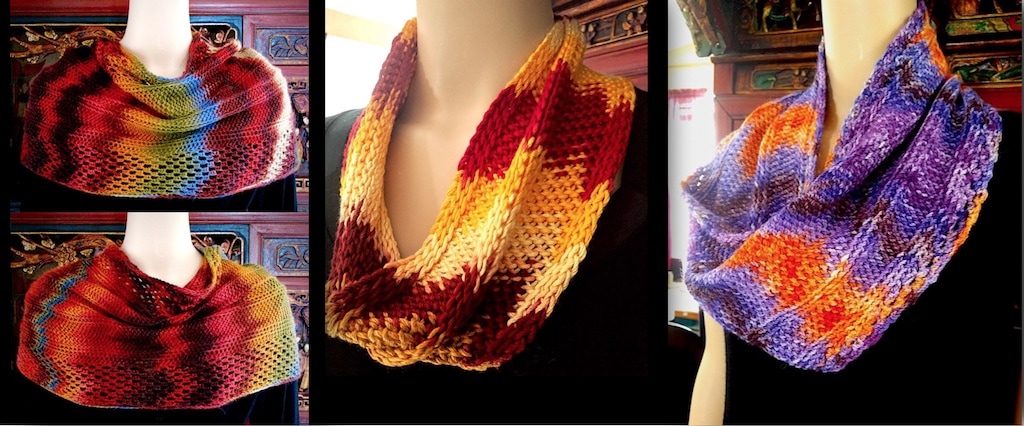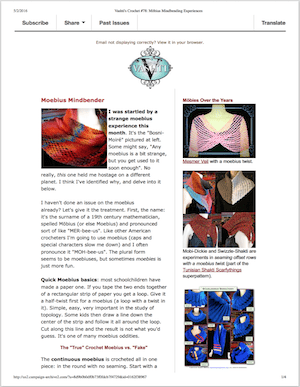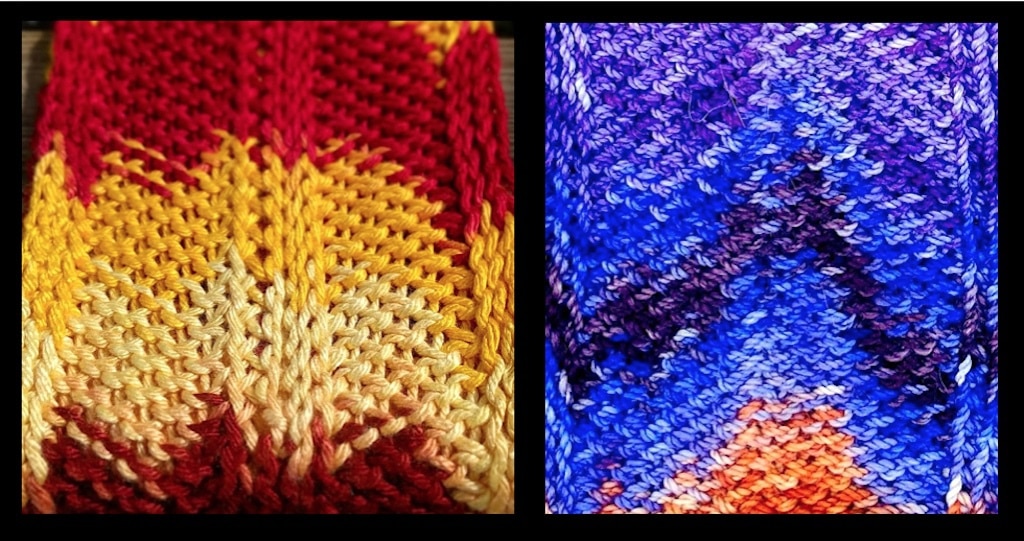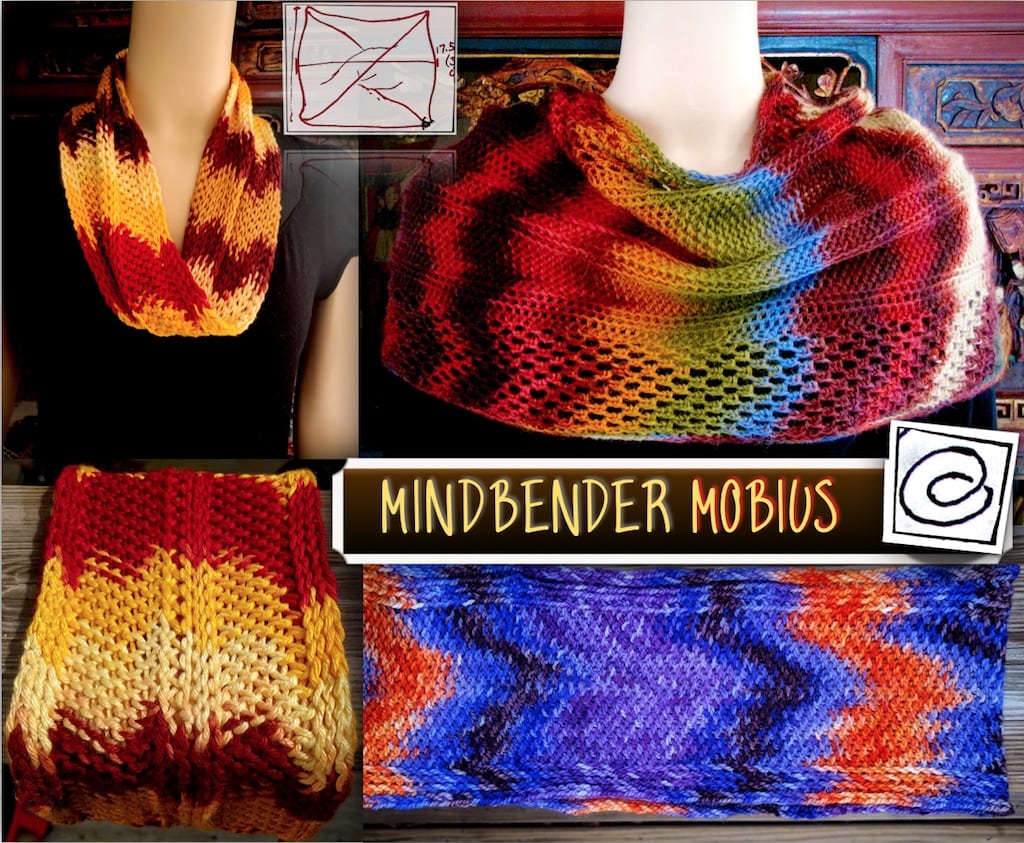I am excited about teaching a class on this special mobius design! It’s one topic of my seven three-hour class topics scheduled for the big Chain Link conference this July (2020) in New Orleans. This crochet conference has been produced every year since 1993 by the Crochet Guild of America. It’s the longest-running national-level conference. (I’m tempted to call it international because over the years many teachers have visited from other countries.)
As we get closer to July I may update this page with discoveries and other news. For example, when I create a Mindbender Mobius Class Resources page. I’ll add a note at the top of this page saying when it was updated last. It’s likely I’d also announce the news in my newsletters, so subscribe (free) if you want to stay in the loop.
Each One is Unique
Each Mindbender Mobius is unique and so is the experience of crocheting it. It’s a true mobius shape and this means it’s crocheted in infinity rounds—picture a figure-8 path. All you do is add a half-twist to the foundation row before joining it into your starting ring. This simple twist introduces features that have fascinated mathematicians for decades. See the newsletter issue I did about it four years ago; I still enjoy reading it.
I’ve made three Mindbenders so far:

What’s So Different About This Mobius?
These Mindbenders don’t look crocheted. I promise zero knitting is involved. It’s 100% crochet with a regular crochet hook, preferably one that is two or three sizes larger than normally used for the yarn you choose.
For the first one on the left I used Misti Alpaca “dyed to the stitch” Hand Paint Sock, a fingering weight yarn. It calls for a 3.25mm or so crochet hook size on the label. I used size 5.5mm. The dyeing method used for it baffled me to no end! This mobius is the test of my theory and proof of my triumph when I finally cracked its true color repeat. I’ll explain what’s going on with this kind of variegated yarn in class. Have a look at this earlier blog post, Hand Dyed Yarn Three Ways about this yarn.

I wanted to try several more things with the first one, and that’s what brings on the mindbending. When colors change quickly in a variegated yarn, like they do in the Misti Alpaca one, slip stitches are fabulous because they take up very little yarn per stitch. Even if you use a big hook. Just look at how slip stitches helped me get the most out every color in the Jempool scarf!
Unlike Jempool though, I couldn’t stack the colors of the Misti yarn unless I crocheted it in the round with no turning. With slip stitches that means Bosnian crochet.
Challenge accepted! I had never tried planned pooling with Bosnian. I knew it would be interesting because it has an innate lean. And what does the lean do if the rounds are figure-8’s? Each round builds on the others on both sides of the foundation. In other words, the foundation (or Round 1) runs down the center of a true mobius. I think of it as its spine.
Mobius Foundation “Spine”
You can disguise/hide the spine, or emphasize it and turn it into a design detail. For this class I found a simple way to make it blend in so well that it’s invisible. (In the projects above you’re seeing mostly planned texture changes in some of the rounds, not the spines.) Look below at a close up of the Dragon Bee and the Renegade mobiuses: it’s quite pronounced in the one on the left; in the Renegade it melts away to nothing. You can’t even feel it.

Here’s another mobius oddity to address: if you’ve ever crocheted a true mobius, you know that not only does the foundation run down the center of it, but all the stitches above the foundation face one way, and all of them below the foundation face the other. It depends on the stitch pattern whether it’s obvious or not. (For example, Doris’ Snow Day is a true mobius and you don’t notice the foundation OR whether the fronts or backs of stitches are facing.)
The back of Bosnian crochet looks distinctly different from the front. It really does look like it’s the back. Tunisian crochet is often like this too. So, what to do? I need to crochet the yarn in the round with no turning if I want to play a moiré color pooling game with it. I could omit the mobius twist and make a simple tube shape, but I wouldn’t be able to add increases to shape it at the shoulders. It would throw off the color stacking. (Have a look at Misti Fondant, which I’ll bring to class. The Mindbender inspired it; I found a way to do it in rounds with turning, plus I shaped it without throwing off the colors by using vertical ribbing.)
It turns out inverse slip stitches work great! It wouldn’t be a mindbender without them. Check the close up photos of the spines above: don’t the stitches match each other on both sides of the spine and look symmetrical?
Prepare to Take This Class
Registration will open in early March. The Mindbender Mobius pattern will be available for the first time in class. The class is rated Advanced. A great way to get up to speed for it is to brush up on three skills:
- Slip stitch crochet. Try one of my slip stitch patterns. For the simplest first experience, try the Slipster Slackscarf or Eva’s Ribs. I designed the Luckyslips Mitts for students of my Slip Stitch Crochet 101 classes.
- Simple planned pooling. After some slip stitch crocheting, try is Jempool. It combines simple slip stitches with simple planned pooling in color stacks. Have a look at my Planned Pooling class resources.
- Crochet a true mobius. Doris Chan’s Snow Day would be perfect!


Student should bring: A few different variegated yarns, and crochet hooks that are about two and three sizes larger than usual for each yarn. Check that some of a yarn’s colors last for at least 6 inches before changing to the next color. Want to use Misti Alpaca Hand Paint yarn like the sock weight one used for the pictured large cowl? Bring a few non-Misti yarns too. Other yarns pictured: Renegade Yarns, Yarn Bee. One skein was used for each project pictured.